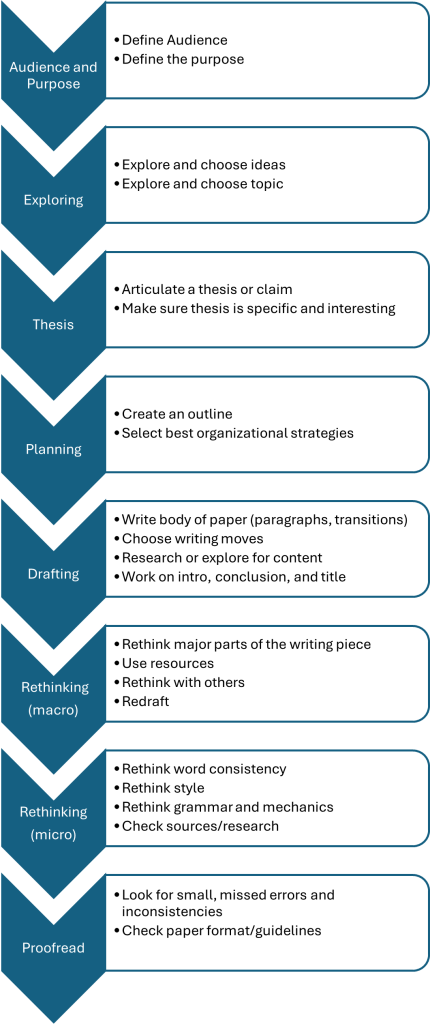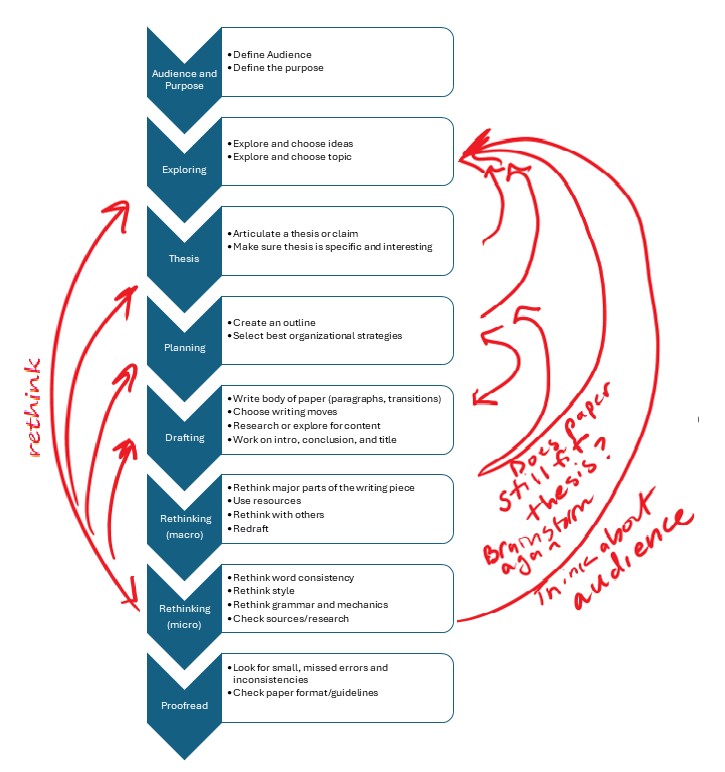2 Chapter Two: A Writing Process for Every Writer

I am terrible at astrophysics! I’ve just never been good at it.
Have you ever heard someone say this? Probably not. However, you’ve probably heard statements like these (maybe you’ve even said them yourself):
“I’ve never been good at grammar.”
“Writing isn’t really my thing. I’m a math person.”
“I’m just not creative, so I can’t write well.”
These statements have echoed across classrooms all over the country, and the response from most teachers of writing is the same: writing takes practice. No one ever woke up suddenly being good at astrophysics or mountain biking or piano playing. Even those who might pick up those activities easily had a foundation of skills and practice to build on and learned their craft differently. This is true for writers, too. This is true for you!
Writing is a process, and although many writers follow a similar process, each writer is unique. Think of your writing process as your fingerprint. It has the same characteristics as most fingerprints, swirls and lines and patterns, but yours is unique to you (that’s why relying solely on Generative AI to do writing for you is a problem…it sounds like a robot (generic!) because it IS a robot). The key to writing well is to know your process and make it work for you.
So, what is a writing process?

These steps are the basics of a writing process, and the process looks pretty clear. However, each writer will spend different amounts of time on the process. Also, writing isn’t this linear. Sometimes it looks more like:

As you can see, the process goes back and forth. You might have a thesis and organization and begin drafting. Then you might realize the thesis isn’t working, so you go back and rethink the thesis. Then the organization will need to change, too. Once the draft is done, the introduction and conclusion might need to be rewritten because they no longer address the audience and purpose, or they just might need to be more engaging.
When rethinking (revising), writers should be check back on all the previous parts of the process: deciding whether the writing meets audience and purpose, whether the thesis still holds true, if the organization is still working, if the style is still clear and consistent.
All writers have a process. The one outlined above may seem like it would take a long time. We can eventually do this rather quickly, though, and it becomes more natural with practice. In fact, you already do this!
Example
Let’s look at an example of something we do all the time: writing a grocery list. Even doing this is a process:
- Who is the audience? Is this for me or someone else? That informs other decisions. For example, can I just write “cereal” because I’m the one going shopping, or do I need to

Shopping List write “Honey Nut Cheerios” because my girlfriend is the one going shopping?
- What is my purpose? Do I want a huge shopping trip with multiple stops or a short in and out? Am I shopping for ingredients for recipes, or for basic staples like milk and bread?
Once audience and purpose have been chosen, the following steps might be taken:
- Create Thesis: Write a heading that leads the audience to the goal. Are you shopping for a major event like a party? Are there specific needs of your guests (vegetarian, gluten free)?
- Explore: What do I need? Make a list.
- Plan: Redo the list based on organization (for a grocery store, it might be how the store is laid out: grocery, meat, canned goods, condiments, dairy, bread). Your goal is efficiency. Get in, get the stuff, get out.
- Draft: Write the list in the organizational format chosen.
- Rethink (macro): Look it over. If the audience is someone else, will they understand what it all means? Did you miss anything? Do you need checkboxes? Do you need to add specific brands, types, or descriptions? Kraft Macaroni and Cheese, not generic?
- Rethink(micro): Is it legible? Are the spelling and words consistent and clear?
- Proofread: Check to make sure everything is there.
Throughout the rest of this book, we’ll keep coming back to this process in more detail.
What kind of writer are you?
In writing, the trick is to find your process, to figure out what you do and how you do it.
What kind of Writer are you?
Are you a sprinter?
- You have lots of ideas and want to get them out quickly
- You probably skip to drafting and spend a lot of time rethinking, sorting through pages and pages of ideas that probably don’t all need to be there.
- Try spending more time on the start of the writing process, defining audience and purpose and exploring and planning; then revising might not be overwhelming.
Are you a jogger?
- Do you try to go through the writing process one step at a time?
- Maybe some parts are harder than others, like organization or writing a thesis?
- Try new strategies for those parts of the writing process that are most difficult. If revision is hard, get lots of feedback and learn to critique others. If audience and purpose make no sense, spend some time looking at how other writers bend their writing to their audiences and purposes.
Are you a tightrope walker?
- Do you want everything to be perfect before you set it down on paper?
- If so, you probably spend a lot of time at the start of the writing process but have more trouble with rethinking.
- Try being willing to make changes in revision based on looking at organization, audience and purpose. Is everything in the paper really working together? Don’t be afraid to get rid of parts and rewrite.
Media Attributions
- Writing a checklist © Designed by Freepik
- Writing process chart 1 © Amy Jo Swing
- writing process markup © Amy Jo Swing
- Shopping list is licensed under a CC0 (Creative Commons Zero) license
The steps involved in creating a piece of writing, including understanding audience and purpose, exploring, planning, drafting, revising/rethinking, and editing.
